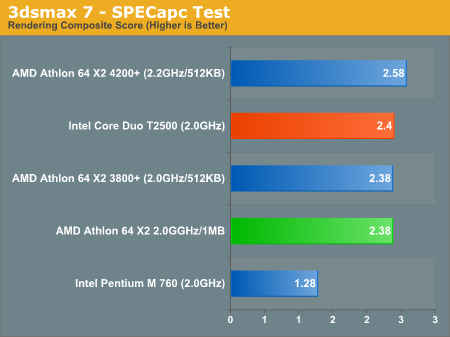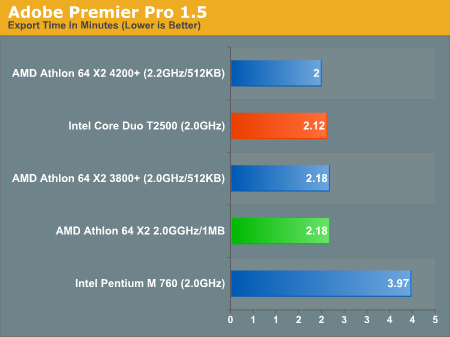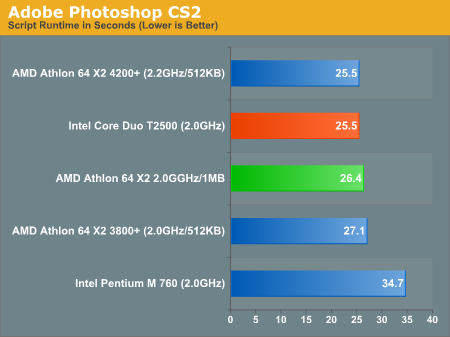Intel Core Duo (Yonah) Performance Preview - Part II
by Anand Lal Shimpi on December 19, 2005 12:55 PM EST- Posted in
- CPUs
Professional Application Performance with 3dsmax, Adobe Premier and Photoshop
We start off our page on professional application performance with an updated version of the SPECapc 3dsmax test, updated for version 7 of the application. The scenes being rendered haven't actually changed, but the reference numbers used to compute the composite scores have, so these scores aren't directly comparable to results from earlier SPECapc tests.
Compared to the Athlon 64 X2, the Core Duo comes out on top, but by a very small margin - once again we're faced with a virtual tie.
The breakdown of the rendering composite score can be found below; the scores in the table are render time in seconds, lower numbers are better:
Moving onto Adobe Premier Pro 1.5, this test is actually one that is used by Intel to showcase the performance of the Pentium 4 processor. With the Pentium 4 absent from this comparison, we were curious as to how it compared to the Core Duo and the Pentium M.
As with virtually any media encoding performance, dual-core processors do extremely well, and this case is no different with the Core Duo T2500 seriously outpacing the Pentium M 760.
The Core Duo T2500 is also able to complete the export process in about 97% of the time of the Athlon 64 X2, which once again ends up being borderline negligible for this test, but it is important to note that this advantage comes without the aid of an on-die memory controller.
Our final test is the only other Intel-supplied test in the suite. This one used to showcase the Pentium 4's performance under Adobe Photoshop CS2 by measuring the time that it takes to run a few filters and resize/export images. The script itself is fairly realistic; however, with Photoshop filters, it is easy to favor one architecture over another, so by no means are these numbers intended to be conclusive of Photoshop CS2 performance.
We start off our page on professional application performance with an updated version of the SPECapc 3dsmax test, updated for version 7 of the application. The scenes being rendered haven't actually changed, but the reference numbers used to compute the composite scores have, so these scores aren't directly comparable to results from earlier SPECapc tests.

Compared to the Athlon 64 X2, the Core Duo comes out on top, but by a very small margin - once again we're faced with a virtual tie.
The breakdown of the rendering composite score can be found below; the scores in the table are render time in seconds, lower numbers are better:
| SPECapc 3dsmax 7 Breakdown | AMD Athlon 64 X2 4200+ | AMD Athlon 64 X2 3800+ | AMD Athlon 64 X2 2.0GHz/1MB | Intel Core Duo T2500 | Intel Pentium M 760 |
| 3dsmax 5 rays | 15.406 | 15.829 | 16.109 | 14.297 | 25.246 |
| CBALLS2 | 20.125 | 22.281 | 22.094 | 21.187 | 42.201 |
| SinglePipe2 | 92.844 | 101.906 | 101.922 | 107.359 | 203.492 |
| UnderWater | 142.938 | 157.219 | 156.203 | 169.188 | 316.055 |
Moving onto Adobe Premier Pro 1.5, this test is actually one that is used by Intel to showcase the performance of the Pentium 4 processor. With the Pentium 4 absent from this comparison, we were curious as to how it compared to the Core Duo and the Pentium M.

As with virtually any media encoding performance, dual-core processors do extremely well, and this case is no different with the Core Duo T2500 seriously outpacing the Pentium M 760.
The Core Duo T2500 is also able to complete the export process in about 97% of the time of the Athlon 64 X2, which once again ends up being borderline negligible for this test, but it is important to note that this advantage comes without the aid of an on-die memory controller.
Our final test is the only other Intel-supplied test in the suite. This one used to showcase the Pentium 4's performance under Adobe Photoshop CS2 by measuring the time that it takes to run a few filters and resize/export images. The script itself is fairly realistic; however, with Photoshop filters, it is easy to favor one architecture over another, so by no means are these numbers intended to be conclusive of Photoshop CS2 performance.

Overall System Performance using WorldBench 5
Media Encoding Performance with DVD Shrink, WME, Quicktime and iTunes










103 Comments
View All Comments
ozzimark - Monday, December 19, 2005 - link
they've got some headroom with clocks to play with, as the recent opterons are showing ;)Beenthere - Monday, December 19, 2005 - link
...and I'm sure some gillible sheep will buy into it.Since the "review" tested apples to oranges AGAIN, it's not of much value for anyone looking to purchase a notebook PC because you used a desktop X2 for comparison to Intel's YAWNER -- a dual core laptop chippie.
To quote this story:
"Intel’s Core Duo launches in January at CES, so if you’ve been thinking about buying a new laptop, we’d suggest waiting at least another month or so. You won’t be disappointed. "
-- Now if that ain't fanboy, what is???
Obviously with Turion stealing a lot of sales from Centrino, it's no surprise Intel is stroking the media to gain as much positive hype on uncompetitive products as it can since it knows it will be at least '07 if not later before it can compete with AMD in any market segment based on performance, value and power consumption. That however won't stop the Intel shilling.
stateofbeasley - Monday, December 19, 2005 - link
AnandTech is one of the most fair review sites on the net and has been one of the biggest champions of AMD products for years. Your "comments" are little more than pathetic insults against Anand, who is and always will be more credible than you.Furen - Monday, December 19, 2005 - link
I think that he is right to some extent, though. I was hoping for a power consumption comparison between Dothan and Yonah to see which one is better for battery life but it never materialized. I would not say that AMD has a Turion that can compete with Yonah but testing Yonah in a desktop setting and then concluding that it's a heck of a laptop chip without comparing it to other laptop chips leaves a bit to be desired. Also, the tone of this review seemed a quite a bit more Intel-appeasing, if you please, as there was nothing in this review that we didn't see before except for flowery praise about how Yonah does very well without an on-die mem controller.That said I must say that all the asking for a 2GHz 1MB L2/core A64 was pretty retarded. There is no 2GHz 1MB/core SKU so including a fake one just for comparison does not really help since there's no way to get something even similar (the 4400+ is the lowest-clocked 1MB L2 X2). It would have been nice to see an X2 4600+ (the second-best A64 SKU) compared to this Yonah (the second-best one) but I guess the 4200+ is more inline with its price.
SpinJaunt - Wednesday, December 21, 2005 - link
An overclocked Opteron 165 or underclocked Opteron 175 might have been an idea? forget about prices.
I think AMD still has some tricks up there sleeves regardless of what there roadmaps might say.
Anemone - Tuesday, December 20, 2005 - link
Eliminating clockspeed and using the best cache available sets the baseline for comparison, by keeping as few items of difference between the chips as possible. I fully agree with the choice, and, moreover, am quite positive there will be something out in the Turion line that will be quite similar to the 2ghz, dual channel, 1m/core cache that was used for testing.I think it's kind of funny to see us finally returning to tests where comparing close to exactly the same clockspeed produces even mildly comparable results. I say that because years ago that's what we used to do all the time, and finally things have come nearly full circle.
:)
Furen - Tuesday, December 20, 2005 - link
Ah, but we still don't know how DDR2 will affect K8 (or K9, as AMD likes to call the dual-cores) performance. Maybe AMD will increase the L2 cache data width from 128bits to 256bits (the Pentium M has a 256bit interface) to make up for the additional latency, though I doubt it.vijay333 - Monday, December 19, 2005 - link
"Now if that ain't fanboy, what is???"It's called giving good advice. Not an Intel owner myself, but even I would appreciate this info as AT obviously has more info on this. Would you rather buy a laptop now and then regret the purchase when something much better comes along in just a month from now? AT is not telling you to buy an Intel based machine, just to wait a month to get a better idea of what your options are. If you have read AT for a while, you should know that they are definitely not biased towards Intel...
tfranzese - Monday, December 19, 2005 - link
Something new and better will always be out "a month from now". Get use to it.bob661 - Monday, December 19, 2005 - link
Looks like just a P-M with two cores to me. Whoop-de-doo.